
Concept explainers
(a)
Interpretation:
Structural formula of 2,5-dimethyl-3-hexane has to be drawn.
Concept introduction:
IUAC gives rules for the naming of chemical compounds. These rules are,
For
In the nomenclature, Find the parent chin first then number the carbon atoms in the parent chain by giving lest number to the unsaturated double/triple bonded carbon followed by designate the substituent in its position in parent chain.
If more than one same substituent were occurs, add a prefix (di-, tri-, tetra-, ect..) in front of parent chain name.
If compound contains double bond means, name end with suffix of ene or if compound contains triple bond means name end with suffix of yne.
Finally the systematic name was written as, the substituent position number with prefix (di-, tri-, tetra-, ect..) of number of substituents followed by name of the substituent then write the parent chain name (which contains large number of carbon atoms in the chain) with suffix of suffix ene/yne.
The parent chain names based on the carbon atoms are,
The substituent names based on the carbon atoms are,
(a)
Explanation of Solution
The structural formula of 2,5-dimethyl-3-hexene is,
From the given name parent compound is 3-hexene, its structure is,
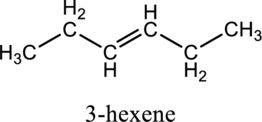
Two methyl groups are present at 2 and 5 positions so substitute methyl groups at 2 and 5 positions to get the complete structural formula of 2,5-dimethyl-3-hexene.
Hence, the complete structural formula of 2,5-dimethyl-3-hexene is,
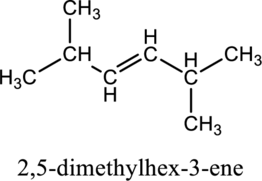
(b)
Interpretation:
Structural formula of 2-ethyl-3-methyl-1-pentene has to be drawn.
Concept introduction:
Refer part (a).
(b)
Explanation of Solution
The structural formula of 2-ethyl-3-methyl-1-pentene is,
From the given name parent compound is 1-pentene, its structure is,
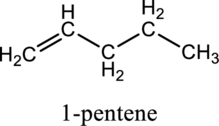
Ethyl group is present at second carbon and methyl group is present at third carbon so substitute these carbon atoms to get structural formula of 2-ethyl-3-methyl-1-pentene.
Hence, the complete structural formula of 2-ethyl-3-methyl-1-pentene is,
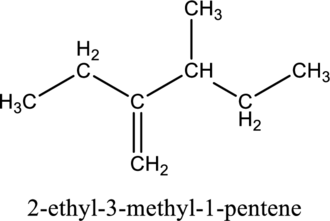
(c)
Interpretation:
Structural formula of 4-methyl-2-pentene has to be drawn.
Concept introduction:
Refer part (a).
(c)
Explanation of Solution
The structural formula of 4-methyl-2-pentene is,
From the given name parent compound is 4-methyl-2-pentene, its structure is,
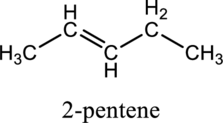
Methyl group is present at fourth carbon so substitute methyl group at 4 carbon atom to get structural formula of 4-methyl-2-pentene.
Hence, the complete structural formula of 4-methyl-2-pentene is,
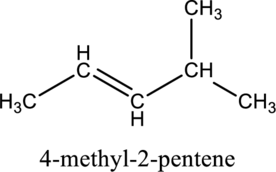
Want to see more full solutions like this?
Chapter 19 Solutions
EBK FOUNDATIONS OF COLLEGE CHEMISTRY
- Explain reasons as to why the amount of caffeine extracted from both a singular extraction (5ml Mountain Dew) and a multiple extraction (2 x 5.0ml Mountain Dew) were severely high when compared to coca-cola?arrow_forwardProtecting Groups and Carbonyls 6) The synthesis generates allethrolone that exhibits high insect toxicity but low mammalian toxicity. They are used in pet shampoo, human lice shampoo, and industrial sprays for insects and mosquitos. Propose detailed mechanistic steps to generate the allethrolone label the different types of reagents (Grignard, acid/base protonation, acid/base deprotonation, reduction, oxidation, witting, aldol condensation, Robinson annulation, etc.) III + VI HS HS H+ CH,CH,Li III I II IV CI + P(Ph)3 V ༼ Hint: no strong base added VI S VII IX HO VIII -MgBr HgCl2,HgO HO. isomerization aqeuous solution H,SO, ༽༽༤༽༽ X MeOH Hint: enhances selectivity for reaction at the S X ☑arrow_forwardDraw the complete mechanism for the acid-catalyzed hydration of this alkene. esc 田 Explanation Check 1 888 Q A slock Add/Remove step Q F4 F5 F6 A བྲA F7 $ % 5 @ 4 2 3 & 6 87 Click and drag to start drawing a structure. © 2025 McGraw Hill LLC. All Rights Reserved. Terms of Use | Privacy Ce W E R T Y U S D LL G H IK DD 요 F8 F9 F10 F1 * ( 8 9 0 O P J K L Z X C V B N M H He commandarrow_forward
- Explanation Check F1 H₂O H₂ Pd 1) MCPBA 2) H3O+ 1) Hg(OAc)2, H₂O 2) NaBH4 OH CI OH OH OH hydration halohydrin formation addition halogenation hydrogenation inhalation hydrogenation hydration ☐ halohydrin formation addition halogenation formation chelation hydrogenation halohydrin formation substitution hydration halogenation addition Ohalohydrin formation subtraction halogenation addition hydrogenation hydration F2 80 F3 σ F4 F5 F6 1 ! 2 # 3 $ 4 % 05 Q W & Å © 2025 McGraw Hill LLC. All Rights Reserved. F7 F8 ( 6 7 8 9 LU E R T Y U A F9arrow_forwardShow the mechanism steps to obtain the lowerenergy intermediate: *see imagearrow_forwardSoap is made by the previous reaction *see image. The main difference between one soap and another soap isthe length (number of carbons) of the carboxylic acid. However, if a soap irritates your skin, they mostlikely used too much lye.Detergents have the same chemical structure as soaps except for the functional group. Detergentshave sulfate (R-SO4H) and phosphate (R-PO4H2) functional groups. Draw the above carboxylic acidcarbon chain but as the two variants of detergents. *see imagearrow_forward
- Assign all the signals individually (please assign the red, green and blue)arrow_forwardThe two pKa values of oxalic acid are 1.25 and 3.81. Why are they not the same value? Show the protontransfer as part of your explanation. *see imagearrow_forwardасть Identify all the bonds that gauche interact with C-OMe in the most stable conformation of the above compound.arrow_forward
 ChemistryChemistryISBN:9781305957404Author:Steven S. Zumdahl, Susan A. Zumdahl, Donald J. DeCostePublisher:Cengage Learning
ChemistryChemistryISBN:9781305957404Author:Steven S. Zumdahl, Susan A. Zumdahl, Donald J. DeCostePublisher:Cengage Learning ChemistryChemistryISBN:9781259911156Author:Raymond Chang Dr., Jason Overby ProfessorPublisher:McGraw-Hill Education
ChemistryChemistryISBN:9781259911156Author:Raymond Chang Dr., Jason Overby ProfessorPublisher:McGraw-Hill Education Principles of Instrumental AnalysisChemistryISBN:9781305577213Author:Douglas A. Skoog, F. James Holler, Stanley R. CrouchPublisher:Cengage Learning
Principles of Instrumental AnalysisChemistryISBN:9781305577213Author:Douglas A. Skoog, F. James Holler, Stanley R. CrouchPublisher:Cengage Learning Organic ChemistryChemistryISBN:9780078021558Author:Janice Gorzynski Smith Dr.Publisher:McGraw-Hill Education
Organic ChemistryChemistryISBN:9780078021558Author:Janice Gorzynski Smith Dr.Publisher:McGraw-Hill Education Chemistry: Principles and ReactionsChemistryISBN:9781305079373Author:William L. Masterton, Cecile N. HurleyPublisher:Cengage Learning
Chemistry: Principles and ReactionsChemistryISBN:9781305079373Author:William L. Masterton, Cecile N. HurleyPublisher:Cengage Learning Elementary Principles of Chemical Processes, Bind...ChemistryISBN:9781118431221Author:Richard M. Felder, Ronald W. Rousseau, Lisa G. BullardPublisher:WILEY
Elementary Principles of Chemical Processes, Bind...ChemistryISBN:9781118431221Author:Richard M. Felder, Ronald W. Rousseau, Lisa G. BullardPublisher:WILEY





